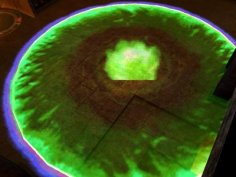 Phil Ewing over at Navy Times makes an interesting catch:
Phil Ewing over at Navy Times makes an interesting catch:
Navy engineers in March began looking into how the fleet should prepare for an attack by one of the most feared and controversial weapons of the modern age: an electromagnetic pulse.
So, even though the U.S. is working to cut nuclear weapons, we’re also preparing to operate in a world where nuclear weapons have proliferated or employed in less conventional ways– in, oh, say, Anti-Ship Ballistic Missiles.
Under the Naval Sea Systems Command (NAVSEA) Force Electromagnetic Effects and Spectrum Management Office, the U.S. Navy EMP Program is reconstituting knowledge lost after the Cold War:
“We have eight scientists and engineers who are providing Navy leadership with information crucial to assessing the fleet’s posture with regard to EMP,” said Alex Solomonik, Navy EMP Program Manager. “Navy Warfare Center EMP experts – with over 80 years combined electromagnetic pulse experience – form an extremely powerful link to past lessons learned.”
The group advises Navy leadership about strategies and safety measures to mitigate EMP damage in the unlikely event a nuclear weapon detonates at an altitude in excess of 40 miles, generating a high altitude electromagnetic pulse.
“The consequences of failing to take appropriate precautions to protect fleet mission critical systems can ultimately prove catastrophic to the Navy’s mission,” said Blaise Corbett, Naval Surface Warfare Center (NSWC) Dahlgren EMP Assessment Group Leader.
So, to do my part in building awareness of this old “new” threat, here’s a primer from the latest CHIPS:
Electromagnetic pulse is a radiated electromagnetic field, typically generated and associated with a nuclear detonation. A nucle
ar device detonated at an altitude in excess of 40 miles generates High Altitude Electromagnetic Pulse (HEMP), which is the focus of the U.S. Navy program. This high-altitude nuclear explosion creates high energy photons known as gamma rays. The photons collide with molecules in the upper atmosphere creating free electrons called Compton electrons, which then interact with the Earth’s geomagnetic field lines to create a HEMP.
HEMP can be characterized as a radio frequency emission with broad frequency content, high electrical field levels up to 100
kilovolts per meter, and high instantaneous power density levels that can exceed 20 megawatts per meter squared.
HEMP is composed of three components commonly referred to as E1, E2 and E3.
E1, often referred to as the prompt component, is characterized by short pulse duration and a fast rise time. The actual EMP experienced is a function of the weapon yield and design, burst height, latitude of the burst, and relative observer location from the burst point.
E2 is often compared to lightning in terms of duration and frequency content (frequencies contained in the signal), while E3 has the longest duration, lowest frequency content, and lowest field levels.
As such, E1 poses the greatest danger to individual electronic systems, while E3 poses the greatest threat to networked infrastructure, such as long line power and telephone networks. The focus of the military is primarily on electronic system impacts due to E1.
EMP is one of those hotly-debated threats. Skeptics are quite right to argue that, oh, an unfortunately timed coffee spill onto a critical keyboard poses an even greater (and more likely) hazard to naval operations.
But in a world where naval platforms are set to last for four or five decades…who knows who will have a nuclear weapon by then? Or, for that matter, how nuclear weaponry will be harnessed?

{ 3 comments }
Since a fire is reported to have knocked out power to the Carnival Splendor, and not nuclear winter, then even if that was a missile, wasn’t it just a “test” missile.
P.S. My mother guards the LGM-30G Minuteman III”Screaming Eagles” so I’m not worried
Blacktail,
You’ll please note that the Starfish Prime test that affected Hawaii was at the *edge* of the radiative field. The detonation didn’t happen over Hawaii or have it deep within the projected field of effect of the EMP, heck they didn’t even think it was *in* the field of effect of the EMP (and one of the Lessons Learned was that the modeled effect was less than the Real World demonstration … one of the reasons to always test in the Real World to build better modelling algorithms and software).
And since the effected infrastructure was much different then the type that has developed since then; “…The EMP damage of the Starfish Prime test was quickly repaired because of the ruggedness (compared to today) of the electrical and electronic infrastructure of Hawaii in 1962. Realization of the potential impacts of EMP became more apparent to some scientists and engineers during the 1970s as more sensitive solid-state electronics began to come into widespread use….” so calling the threat of Nuclear-Pumped EMP’s “completely FAKE” is wrong and ignorant of reality. But referring to the extreme Left’s nomenclature for these weapons at least tells the rest of us the tint of your glasses.
The “threat” of Nuclear-Pumped EMPs is completely FAKE.
The largest Nuclear EMP ever recorded only managed to blow-out a few streetlamps in Hawaii — and NONE of the “dlicate” civilian electronics in the Hawaiian Islands, nor any of the military electronics in the military vessels, vehicles, aircraft, or C3I systems in the area around the multi-Megaton blast;
http://www.alternet.org/story/25738/
On the Left, EMP weapons are knwon as “Newt Bombs”;
http://www.tnr.com/article/the-newt-bomb-0
Comments on this entry are closed.